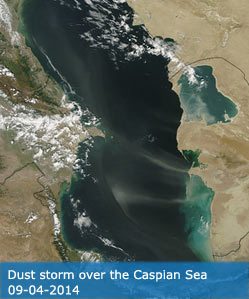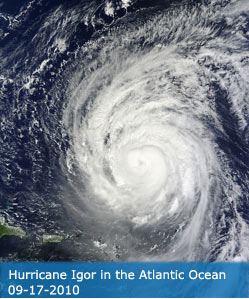Images
April 7, 2025 - Heavy Snow in the Dakotas and Minnesota
Tweet
From April 1-2, 2025, a late-season storm blanketed parts of South Dakota, North Dakota, and Minnesota with fresh snow. Called the “April Fool’s Day Storm” by local media in Minnesota, the storm first wound up over that state on April 1, creating slick roads and white-out conditions before walloping the Dakotas the next day.
According to Minnesota Weather News, the April Fool’s Day Storm impacted the state’s Northland the hardest. Snow totals in Hovland, a community located in the northeastern part of the state on the North Shore of Lake Superior, were the highest in the state, coming in at 15.2 inches (38.6 cm). Fergus Falls was a close second, with 15.1 inches (38 cm). The towns of Cormorant and Finland received 14.8 inches (37.6 cm) and 14.4 inches (36.6 cm), respectively.
By April 2, both North and South Dakota were feeling the storm’s impact. Local media reported dangerous driving conditions with poor visibility and multiple slide-offs occurred in several locations. By the end of the day, snow totals included 8 inches (20.3 cm) in Ellendale and LaMoure, both located in southeastern North Dakota. The highest total in South Dakota reported by media outlets was 9.3 inches (23.6 cm).
On April 3, skies cleared enough for the Moderate Resolution Imaging Spectroradiometer (MODIS) on NASA’s Aqua satellite to acquire this false-color image of fresh snowfall across the region. North Dakota sits in the northeast, above South Dakota, which has the Missouri River curling through its center. Minnesota lies to the east, with the Minnesota River forming a border between South Dakota and Minnesota.
In this type of image, snow and ice appear electric blue, clouds typically are bright white although cold, high clouds that hold ice crystals may have a tint of electric blue. In addition, vegetation looks green, open land shows as tan, and water appears dark blue.
Image Facts
Satellite:
Aqua
Date Acquired: 4/3/2025
Resolutions:
1km (258 KB), 500m (621.1 KB), 250m (1.2 MB)
Bands Used: 7,2,1
Image Credit:
MODIS Land Rapid Response Team, NASA GSFC
Tweet
From April 1-2, 2025, a late-season storm blanketed parts of South Dakota, North Dakota, and Minnesota with fresh snow. Called the “April Fool’s Day Storm” by local media in Minnesota, the storm first wound up over that state on April 1, creating slick roads and white-out conditions before walloping the Dakotas the next day.
According to Minnesota Weather News, the April Fool’s Day Storm impacted the state’s Northland the hardest. Snow totals in Hovland, a community located in the northeastern part of the state on the North Shore of Lake Superior, were the highest in the state, coming in at 15.2 inches (38.6 cm). Fergus Falls was a close second, with 15.1 inches (38 cm). The towns of Cormorant and Finland received 14.8 inches (37.6 cm) and 14.4 inches (36.6 cm), respectively.
By April 2, both North and South Dakota were feeling the storm’s impact. Local media reported dangerous driving conditions with poor visibility and multiple slide-offs occurred in several locations. By the end of the day, snow totals included 8 inches (20.3 cm) in Ellendale and LaMoure, both located in southeastern North Dakota. The highest total in South Dakota reported by media outlets was 9.3 inches (23.6 cm).
On April 3, skies cleared enough for the Moderate Resolution Imaging Spectroradiometer (MODIS) on NASA’s Aqua satellite to acquire this false-color image of fresh snowfall across the region. North Dakota sits in the northeast, above South Dakota, which has the Missouri River curling through its center. Minnesota lies to the east, with the Minnesota River forming a border between South Dakota and Minnesota.
In this type of image, snow and ice appear electric blue, clouds typically are bright white although cold, high clouds that hold ice crystals may have a tint of electric blue. In addition, vegetation looks green, open land shows as tan, and water appears dark blue.
Image Facts
Satellite:
Aqua
Date Acquired: 4/3/2025
Resolutions:
1km (258 KB), 500m (621.1 KB), 250m (1.2 MB)
Bands Used: 7,2,1
Image Credit:
MODIS Land Rapid Response Team, NASA GSFC




